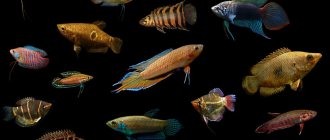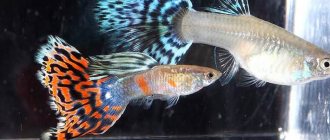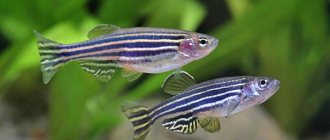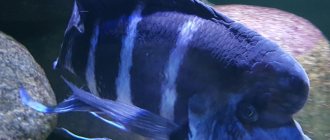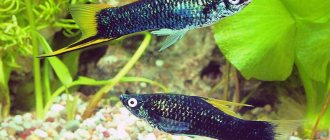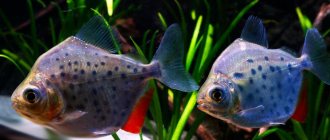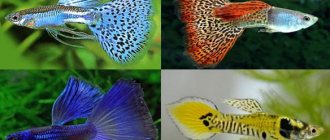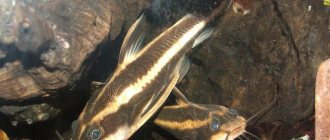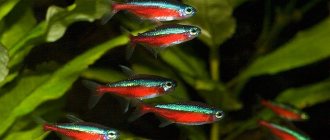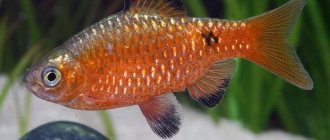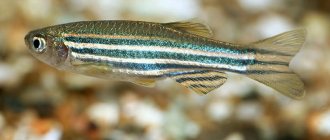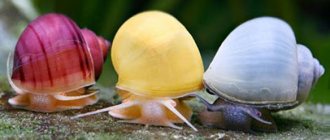Hello to all aquarists! This post will focus on the pink zebrafish. Let me immediately explain that this species belongs to the breeding form of zebrafish (lat. Danio rerio), and not to those fish that, in comparison with the breeding ones, are considered true pink zebrafish (lat. Brachydanio albolineatus), but also, like zebrafish, live in India.
True pink zebrafish (lat. Brachydanio albolineatus)
It should be noted that the work of the breeders was not in vain and the pink zebrafish gained enormous popularity, but at the same time, I think, some kind of disadvantages appeared.
Pink zebrafish is a breeding form of zebrafish (lat. Danio rerio)
For example, according to my observations, pink zebrafish are more prone to diseases; besides, the selected fish are somewhat smaller than ordinary zebrafish. But now the elegant pink danios are still just as nimble and cheerful and very interesting to watch.
Description
All zebrafish belong to the carp family of the order Cypriniformes. These include long-known and popular among aquarists: long-horned beetles, zebrafish, loaches and spined loaches. They are common in Europe, Asia, Africa and North America. All cyprinids lack an adipose fin. Longhorned beetles and zebrafish are in many ways similar to characins and occupy an ecological niche in Asia that belongs to the latter in America. When keeping zebrafish, they need to be given herbal supplements. Carp-like animals do not care for their offspring.
In an aquarium, zebrafish grow no more than 5-6 centimeters. Their body is elongated and painted silver with bright blue stripes. Young veiled species have short fins, and when they grow back they form a veil. The edges of the fins may be yellow. A distinctive feature of the difference between a female and a male is the abdomen - in the female it is much thicker. Males, as a rule, are always slimmer than females. The average lifespan of zebrafish is 3 years.
How to choose the right fish when buying and what to look for?
Pink Danios are attractive, unpretentious fish that are a good choice for both beginners and experienced aquarists. When purchasing, you should adhere to the following principles:
- It is preferable to choose young individuals, because they are more hardy and take root better due to their age;
- You should carefully examine the appearance of the fish, they should not be damaged;
- evaluate the behavior and give preference to those fish that have a sharp and energetic disposition.
If the choice was made correctly, then Pink Danios will delight the caring owner for a long time with their colorful appearance and active behavior.
Danio pink content
Keeping pink danios just like their ancestors zebrafish is not at all difficult. Although zebrafish are not demanding of a large volume of water, they love clean lake water, so an aquarium for keeping pink zebrafish must have a fairly strong biological balance, which cannot be created in small aquariums, so the minimum aquarium volume is 50 liters. Hydrochemical parameters of water: hardness 5-15°, acidity 6.5–7.5.
It should be noted that the recommended water temperature parameters for keeping zebrafish from different sources may vary. For example, somewhere you may be recommended 21-25° degrees or even 18-23° C. This water temperature should be considered conditional because in real conditions, when keeping zebrafish in a common aquarium, it will have significant deviations.
Think for yourself, no one will recommend that you keep fish in a general aquarium at a temperature of 18-23° degrees, knowing full well that the rest of the fish will die out from hypothermia and disease. I keep zebrafish at a temperature of 24 to 26° degrees.
Pink zebrafish tolerate temperatures of 28° degrees well, but at elevated temperatures, females’ eggs quickly mature and the risk of developing a cyst increases significantly. Danio rerio are to some extent considered cold-water, but when kept in a community aquarium, they adapt perfectly to warm water.
Possible diseases
The pink danio has good health and a strong immune system. However, poor-quality nutrition and a polluted water environment can provoke the development of a number of diseases:
- Flatulence . It is easy to notice by the bloating and passivity of the fish, which spends most of its time at the bottom of the aquarium. Treatment is carried out with the help of Trichopolum.
- Bug-eyes - occurs due to pollution of the aquatic environment. Lack of treatment leads to complete blindness. Therefore, you should clean the aquarium, disinfect it, and replace the water. If these measures do not help, then contact a veterinarian.
- Formation of growths . In this case, salt baths will help. It is necessary to dilute salt in warm water (at the rate of 1 tablespoon per 1 liter of liquid) and place the sick fish in a container with saline solution. The optimal time for the procedure is 15-20 minutes.
- Tuberculosis . It is a contagious disease, so at the first sign of it, sick individuals should be placed in a separate aquarium to avoid the spread of infection. Treatment is carried out using food with the addition of antibiotics. Only a doctor should determine medications and their dosage.
- Intoxication . Nitrate poisoning can manifest itself as restlessness and fish swimming in circles. In this case, it is necessary to completely replace the fluid in the artificial reservoir and change the water daily by 30% of the total volume for a week.
Pink Danio is a beautiful, graceful, peace-loving fish. The absence of a tendency to diseases, manifestations of aggression, and a peaceful attitude towards other inhabitants of an artificial reservoir have made this ornamental fish one of the most popular among aquarists.
What to feed pink danios
Danios are omnivores and do not refuse dry gammarus, daphnia and specially produced artificial food. As a herbal supplement, they can be given steamed and well-washed semolina or just a crumb of white bread. Among artificial foods, grated beef heart is loved. But the fish menu should not consist only of dry and artificial food. To maintain health, they need to be fed with live food.
Among the live foods zebrafish love are: small bloodworms, coretra and daphnia. If necessary, and especially in winter, live food can be cultivated for them at home. For example, Daphnia moina is well suited for these purposes.
Zebrafish are fast and preferentially stay in the upper layers of water and, when food is added, they eat first.
Proper feeding
Danios love to eat, so overfeeding them is not recommended to avoid obesity. Once a week you need to give your pets a fasting day. You can feed both frozen and live and dry food.
Fish eat with pleasure:
- daphnia;
- bloodworm;
- small insects and their larvae;
- any dry food.
When feeding only dry food, a decrease in immunity may occur. It is recommended to periodically introduce live or frozen food into the diet.
Don't forget to vary your food
Zebrafish diseases
Pink danios are quite hardy and unpretentious, but they get sick just like other species. The most common disease is ichthyophthyriosis. Symptoms of the disease: scratching of the fish on the ground, compression of the fins and the appearance of a white coating in the form of small grains (semolina) on the body of the fish and fins.
The causative agent of the disease is an equiciliated ciliate that parasitizes the body of fish, but it usually affects fish with a weakened immune system. The cause of an outbreak of ichthyophthyriosis can be an undesirable decrease in water temperature, as well as inadequate nutrition, which leads to depletion of the fish’s body. Sick fish can be cured with the drug bicillin 5. The procedures are carried out both in a general and separate aquarium. When growing delicate plant species in an aquarium, the second option is preferable.
Habitat
The historical homeland of this fish is considered to be India and Indochina, Asia. The pink zebrafish lives in cool freshwater bodies of water. In European countries, they learned about this fish at the beginning of the last century, and it soon gained immense popularity among aquarists around the world.
Today, the pink zebrafish is bred by breeders and is on the verge of extinction. Therefore, it can be found much more often in artificial reservoirs than in the natural environment.
Danio pink breeding
I have bred zebrafish many times and I will tell you that these fish are very easy to breed. Young individuals willingly go to spawn, and spawning can be observed even in a community aquarium. Once I had the opportunity to observe the appearance of fry preserved in the thickets of plants. The fry, feeding on ciliates and leftover food, grew up, became bolder and joined the flock.
There are two ways to arrange zebrafish spawning, with and without preparation. In the first case, approximately a week before the planned spawning, it is necessary to separate the males and females. For example, this is how I do it: I put males in a spawning tank and after 4-5 days I add females to them. The second method depends on random spawnings in a common aquarium, and since such spawnings are unexpected, there is no need to plan them for some time.
However, if you change half or a third of the water in the evening, then spawning will most likely begin in the morning hours. In this case, you need to catch the spawning fish and place them in a spawning tank where spawning, as a rule, can continue successfully. I have used this method many times and I can say that it is 99% trouble-free.
Glofish aquarium - all the colors of the rainbow
There will be live illumination in the aquarium! Such an unusual technology: first shine the light on the fish, so that later, in the dark, it lights up in response!
Wonderful, isn't it?
The phenomenon of fluorescence sounds loud in medicine (carrying out the most important tests), with the help of it our banknotes are provided with an additional degree of protection against counterfeiting, in forensic science it helps to solve crimes where there are traces of blood, but the most unimaginably pleasant use of the glow is to create a unique design in your aquarium . Glofish is a joy for both children and adults. Try to create an aquarium in the GloFish style!
Video about glofish fish
Zebrafish Spawning
This time I am breeding pink danios. There is absolutely nothing new for me. I have live food and a well-established technique for raising fry. I breed these fish because they are beautiful and a grown school should definitely decorate my aquarium. I brought pink danios from the city of Ruzaevka when I was there on a business trip.
Initially, I didn’t plan to buy, but just before leaving I decided to visit a pet store to buy some fish as a souvenir. Since zebrafish are hardy fish, and it took me more than 12 hours to travel home, I chose pink zebrafish. And upon arrival home, I planned to breed pink danios there in Ruzaevka.
Danios are undemanding about the size of the spawning tank, and anyone who bred these fish knows well that you can use just an ordinary three-liter jar for a spawning tank. But this option is considered not preferable because the hatched fry will still have to be moved to a nursery aquarium, and this is associated with a certain risk of their loss.
Well, if that’s the case, then it’s time to move the fry from the jar to the nursery aquarium correctly. There is no need to suffer and catch the fry with a spoon, ladle or net. Also, you cannot pour them out of the jar, but you just need to put the jar in an aquarium in which the water level is higher, then place a hose with a sprayer in the jar and quietly turn on the aeration. A small stream of water will help the fry get out of the jar.
To breed pink danios I will use a 20 liter spawning tank. I will install the aeration and set the heater to 26° degrees, and as a protective net I will use a synthetic rope untangled and crumpled, and then pressed on top with stones.
The net does not cover the entire bottom of the spawning tank, but as they say, this is beneficial and I will not need to eliminate the excess part of the fry. I will place the mesh in the center because I think this is where the middle part of the spawned eggs will be preserved.
Danios can spawn in pairs, but if the males are no longer young, then two or more males are added to one female. In the evening I added one female to four males. Among the selected males there were males with the following color variation: two males of a bright pink color, one with a dark pink tint, and another male with the zebra zebra variation who, for some reason, did not participate in the spawning at all.
The next morning, spawning began. It lasted about an hour, after which I immediately transplanted the breeders into a common aquarium. On the third day the larvae appeared, and on the fourth or fifth day the fry swam.
Comparison of the present species with the selection one
As already noted, there are two similar species of pink Danio, so aquarists often confuse them. The so-called True Pink Danios (lat. Brachydanio albolineatus) live in the wild, and ordinary Pink Danios were obtained through selective breeding (lat. Danio rerio) .
To avoid confusion, many fish breeders have agreed to call the breeding breed Danio Roseus. The present species is called the Pearl Danio.
As a rule, Pink ones look more attractive than Pearl ones. The latter have a silver-gray body color that can shimmer in the light. From the middle of the body to the caudal fin, these fish have a bright orange stripe, thanks to which they can be quickly distinguished from the breeding Pink Danios.
Pink zebrafish fry
Since the Daphnia nauplis were still large for the tiny fry, I used boiled yolk as a starter food. But I only managed to feed the yolk for two or three days because the fry had already begun to eat the daphnia, which I added to the fry as soon as they swam.
I always used ampullaria snails as orderlies, but this time I didn’t have them, and I added a small ancistrus to the fry, which also did a good job of eating the fallen yolk particles from the bottom.
The fry fed the yolk from his finger, that is, without washing the yolk, since the milk, consisting of microparticles of the yolk, which muddies the water, was eaten by the daphnia, and the water was always clean and transparent. Today the fry are three weeks old. They are already eating scraped beef heart and the largest of them can begin to be transplanted into a common aquarium.
The growing school contained fish with different color variations: pink, dark pink and white albino. The appearance of albinos suggests that the pink zebrafish, as a selected species, is easily split and to preserve it, constant selection must be carried out.
Compatibility with other fish
Pink Danios are small, schooling fish with a peaceful nature. Similar sized species are suitable as neighbors: guppies, neons, and others. Species such as barbs, ternets, cichlids or catfish can injure small, peaceful Danios.
We recommend reading in more detail about the compatibility of Danio with other fish in a separate article, which is entirely devoted to this particular topic, which can be accessed using this link.
Tetradon dwarf
Dwarf tetradons are small aquarium fish that live in fresh water. Their body dimensions do not exceed 3 cm. The shape of the body is round, the eyes are large, and horny plates are located in the oral cavity. The color is olive-yellow with large dark spots.
Tetradons are kept in schools of 5-6 pieces in aquariums with a volume of 30 liters or more. Fish prefer a temperature of 24-27°C, pH 6.6-7.7 and dH 5-22°. The species is sensitive to the presence of nitrogenous compounds in water; good filtration with low flow, aeration and weekly changes of 1/3 of the volume are required. Tetradons are predators; They feed on snails, insects and small crustaceans. They can eat smaller fish, and the fins of large species are torn off.
Price
Today, pet stores offer aquarium danios of all types. Among them you can find pearl fish and danio roseus. Experienced aquarists recommend buying juveniles; they adapt faster and better to new conditions. The price of one fish depends on the size and condition. There is a wide range of prices for zebrafish. So pink danio (pearl) costs 25-30 rubles for one tail, while danio roseus (rerio) can be bought for 35-45 rubles. Therefore, those who are taking their first steps in the aquarium hobby should learn to navigate prices well.
Although zebrafish are unpretentious to keep, how long these fidgets will please you depends on the conditions created by them. Therefore, having decided to place them in your home pond, it is worth learning as much as possible about caring for them in order to ensure your pets a long and healthy life. If you liked the article, leave comments and share a link to it on social networks.
Microassortment of erythromicron
Microrasbora erythromicrons are small aquarium fish. The size of adult individuals does not exceed 3 cm. The body color is orange-pink with a large number of wide vertical dark blue stripes on the sides, the fins are reddish.
Microbreeding is kept in groups of 10 individuals in aquariums with a volume of 30 liters or more, planted with plants. Fish prefer a temperature of 21-25°C, pH 7-8 and dH 5-12°. Lighting should be moderate. Filtration, aeration and regular water changes are necessary. They feed the microbill with any food of a suitable size: dry feed mixtures, cyclops, daphnia, brine shrimp. The species has a peaceful disposition and gets along with neighbors of a similar size.
general information
A distinctive feature of the aquarium fish Ornatus is its almost transparent almond-shaped body, flattened on the side, which is covered with tiny scales of various shades. All representatives of the species are characterized by agile behavior, so in home aquariums small schools of fish actively move from one side to the other, trying to change their direction while moving.
Individuals have a two-lobed tail, a raised dorsal fin that resembles a sail, and dark spots near the gill slit. Ornathus is native to French Guiana and the lower Amazon.
Under natural conditions, fish lead a relatively peaceful lifestyle, because even males, who like to engage in territorial disputes, never attack their fellow fish, but only take a threatening pose, bending their torso and spreading their fins widely. The likelihood of fights with a fatal outcome is practically excluded.
Ornathus also do not conflict with other peaceful fish, including:
- carp thorns;
- Gurov;
- Ancistrus;
- acanthophthalmus.
By nature, Ornatus is a friendly fish. In addition, she is ready to join other flocks when dangerous situations or other animals appear in the aquarium.
